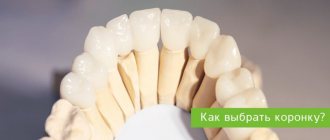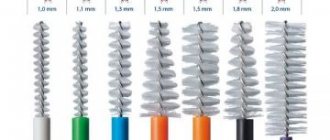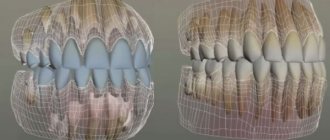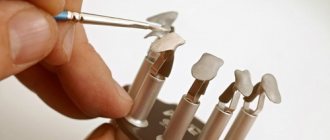How does a chemical filling differ from a light filling?
When a patient goes to a public dental clinic with a medical insurance policy to get a filling, the doctor may offer him to “pay extra for a light filling.”
This often causes misunderstanding among the patient and is a source of conflict situations. What's the matter here? Let's try to figure it out in this article. Today's state guarantee program in Moscow and some other regions of the country clearly divides fillings according to the class of material used. Fillings made of cement and a chemically cured composite are installed free of charge, while fillings made of a “light” composite, which are installed using a special lamp with blue light, are installed at the expense of citizens, i.e. paid. In what cases can you limit yourself to a free chemical filling, and when is it worth paying extra for a light filling?
To understand the difference between these technologies, let’s look at the history of the development of dental materials for restoring hard dental tissues. Until the middle of the last century, the most common material for filling teeth was amalgam - a mixture of silver, mercury and other metals. Such metal fillings are still widely installed in many foreign countries – in budget dentistry. In our country, amalgam was abandoned in the 90s in favor of composites and cements, which at that time had already proven their effectiveness thanks to the development of technology.
Cements
So-called glass ionomer cements are widely used in modern dentistry. They are a mixture of powder - finely ground glass and liquid - organic acid or water. These two components are mixed, the resulting mixture is filled with a carious cavity, the liquid reacts with the environment, and the filling becomes solid.
Cements have many positive qualities:
- biocompatibility with dental tissues
- release of fluoride ions, which helps prevent secondary caries
- no material shrinkage
- matching teeth color
- quick placement of a filling without the use of adhesives (“glue” for fillings)
- low cost
However, despite all the positive properties, they also have their significant limitations:
- the adhesion of cements is approximately 10 times lower than that of composites, so fillings made from cements fall out more often;
- cements are not strong enough, they cannot restore the surfaces of chewing teeth;
- cements have a liquid consistency, they cannot be used to restore the missing part of a tooth, they can only fill cavities;
- cements are opaque and cannot be used for fillings on the front teeth, since such fillings will always be visible.
Cements are often used as a cushioning material for composites when filling large cavities (biocompatibility, no shrinkage). They are widely used in pediatric dentistry on baby teeth, as well as for any temporary fillings. With the help of cements, it is possible to place small, full-fledged fillings where there are no chewing loads, for example, in places where teeth touch in cases of shallow caries.
In all other cases, cement fillings are precisely the “budget” option - fast and free. You can judge the quality for yourself when such a filling falls out or crumbles.
Chemical composites
The invention of the acid etching technique (Buonocore, 1965) and the use of Bis-GMA monomer as a component of the filling material (Bowen, 1962) ushered in the “age of adhesive dentistry.” The first chemical composites appeared in the mid-60s of the last century. At that time, composite materials did not yet have particularly outstanding qualities compared to cements and plastics, so their use was limited. However, composites have shown higher strength and higher rates of adhesion to dental tissues due to the use of adhesives.
The widespread use of composite materials began at the turn of the 1980s, when light-curing materials appeared. The advantage of light-based materials over chemically cured composites quickly became obvious, and therefore many manufacturers of dental materials closed the production of chemical composites and completely switched to the production of light-cured ones. All scientific developments in the field of chemical composites were curtailed in favor of “light”. It is safe to say that luminous composite materials have replaced chemically cured composites.
Today, chemical composites are a dead-end branch of evolution. These are materials developed in the 70s of the last century. Most modern dental clinics, both abroad and in Russia, do not use chemical composites.
The only advantage of chemical composites is their lower price, due to which they have become, in addition to cements, another “budget” material. However, the significant disadvantages of chemical composites give reason to think about whether it is worth “ruining” a tooth with a chemical filling or is it better to find funds and pay extra for a light one.
The adhesion of chemical composites is several times lower than that of light composites; accordingly, fillings will fall out. The main problem of all composites is shrinkage during polymerization, which leads to disruption of the marginal seal and separation of the filling in the area of the bottom of the cavity, which, in turn, leads to inflammation of the pulp - pulpitis.
Chemical composites could be used for very small fillings, but the thing is that in adults there are practically no small cavities. A small black dot on the surface of a tooth, like the tip of an iceberg, hides a significant amount of carious tissue that requires removal.
The use of chemical composites in pediatric dentistry is also inappropriate, since it is better to use modern glass ionomer cements on primary teeth.
Thus, placing a filling made of a chemical composite is nothing more than the first step towards further destruction and loss of the tooth. That's the whole "budget" for you.
Light-curing composites
Luminous composites have been the most common filling material worldwide for many years. In the 1980s, materials with different sizes of filler particles appeared, intended for filling different groups of teeth: macrofilled (macrophilic), microfilled (microphilic), hybrid. In the 90s, all manufacturing companies worked on the development of universal filling materials. With the advent of “nano” technologies, truly universal materials – nanohybrids – have become available to dentists. Today, such composites are available in every dental office.
The main problem of any composite materials, shrinkage during polymerization, was solved by applying the material in small portions and exposing it to light. As you understand, this is impossible with chemically cured composites, since the patient would have to sit for several minutes with his mouth open, waiting for the next portion of the material to harden.
Light composites today are often called restoration materials rather than filling materials. With their help, you can not only place fillings, but also carry out any complex aesthetic and functional restorations. The technology of curing the material with light has turned dentists, who previously only placed fillings, into artists and sculptors. Now they can select materials based on color and transparency, combining them with each other. They can restore even completely destroyed teeth, repair old fillings and restorations, turn crooked teeth, restore the surfaces of front teeth and much more.
Read also: Tablets for toothache during pregnancy
Undoubtedly, working with light composite materials requires a highly qualified dentist, therefore, if you are interested in aesthetic restoration, carefully choose a doctor, focusing on examples of his work and recommendations from friends.
To summarize, we can provide a comparative table of the properties of chemical and light curing composite materials.
Chemical composite
- Can be applied in only one layer - high shrinkage, caries develops under the filling, fillings fall out
- Lack of adhesion to dentin, adhesion only to enamel
- You can only fill cavities
- When mixing two pastes, the properties of the material deteriorate under the influence of oxygen
- You can use only one shade of the material - HC is not applicable for front teeth
- The adhesive and the material itself were developed in the 1970s
Light composite
- Can be applied in small portions to reduce shrinkage, the service life of the filling is 10 years or more
- The presence of special primers and adhesives for dentin, the adhesion force to enamel is higher than that of CC
- Everything can be restored – even missing parts of the tooth
- The material in the form of a single paste is removed from the syringe
- You can combine different shades of material - for any group of teeth
- Lighting materials have progressed over the past 30-40 years
As mentioned above, chemical composites have, perhaps, the only advantage over light ones - a lower price. That is why they became material for the budget. Insurance companies do not pay for more expensive lighting materials. Vivat insurance medicine!
The second “advantage” of chemical materials is faster work with them. Indeed, chemical fillings are installed quickly, the material is applied in one portion, and there is no need to expose it to light. This allows you to meet the 20 minutes allotted for an appointment with one patient in our valiant budget dentistry. But the question is - how long will such a filling last - a month? At best, six months to a year. What then? Grind the tooth again, and when there is nothing left to grind, remove the tooth. Then prosthetics with grinding of adjacent teeth, gradual loosening of the supporting teeth, over time - removal of the remaining teeth, and removable dentures at the age of 50-60 years. But that is not all. As a result of wearing removable dentures, there is atrophy of the alveolar ridge, a decrease in facial height and an senile grimace at 60-70 years of age. Are you happy with this prospect? Then continue to receive treatment at free dentistry and feel free to get chemical fillings.
For those who are concerned about the health and beauty of their teeth and face, we recommend that you take into account everything outlined in this article and, following the recommendations of your dentist, pay extra for a high-quality light filling. And also do not rush to remove diseased teeth, doing everything possible. to preserve and cure them.
Classification of composites
The complexity and ramification of the classification of dental materials is explained by the wide range, constant updating, variety of types and shapes of its components.
The classification takes into account:
- chemical composition;
- filler fraction sizes;
- particle composition;
- degree of filling;
- curing method;
- consistency;
- appointment.
Chemical composition
Based on the chemical composition of the matrix, composites are divided into:
- traditional;
- ormokers.
The latter stands for “organically modified ceramics.” This is a new type of dental compositions that emerged as a result of the improvement and modification of traditional matrices.
Ormokers have increased biological compatibility (the amount of free monomers in them is reduced to a minimum), low shrinkage (1.9%), a stronger connection with the filler and high physical and mechanical characteristics.
Filler particle sizes
This parameter affects such important properties as wear resistance and polishability. The smaller the filler grain, the higher the wear resistance and the longer the dry shine lasts.
Large fractions (more than 0.1 microns) are obtained from metal salts - aluminum, barium, lithium, strontium, titanium, as well as glass and quartz. The nanofiller is made from silicon dioxide. If the material contains filler with different grain sizes, the average value is indicated in the description.
The following types of substances are distinguished depending on the size of the filler particles.
- microfilled - grain sizes vary in the range of 0.04-0.4 microns;
- mini-filled – 1-5 microns;
- macrofilled – 8 microns or more;
- microhybrid - there are 2 types of filler - with particle sizes of 1-5 microns and 0.04-0.1 microns;
- macrohybrid – 8-12 microns and 0.04-0.1 microns;
- hybrid maximum filled (totally completed) compositions – 0.01-0.1 microns, 1-5 microns, 8-5 microns, 1-5 microns;
- nanofilled (nanocluster) – up to 100 nm;
- nanohybrid - a mixture of sizes 0.004-3 microns.
Particle composition
The simultaneous use of coarse and fine filler particles has been found to improve abrasion resistance, strength and edge seal. It also brings the value of its thermal expansion closer to the values that tooth tissue has.
Based on the type of particle size combination, the following are distinguished:
- Homogeneous (microfilled, macrofilled, minifilled).
- Heterogeneous (micro- and macrohybrid, nanohybrid, maximally filled).
- Totally fulfilled (include particles of different sizes - micro, macro, mini). The degree of filling of these materials is 80-90%, shrinkage is 1.7-2.0%.
Filling level
Composites for dentistry are characterized by fullness - the weight or volume content of the filler in the matrix, expressed as a percentage. The degree of filling determines many properties - shrinkage, radiopacity, optical characteristics, strength. The higher the fullness, the stronger the substance, the lower the shrinkage, the better the radiopacity. According to the degree of fullness, substances are divided into:
- highly filled – above 70% by weight;
- medium-filled – 65-75%;
- weakly filled – less than 65%.
Curing method
The process of polymerization (hardening) of the matrix consists of the transformation of low-molecular compounds (monomers) into large-molecular compounds (polymers). The reaction occurs due to free radicals formed when the polymerization initiator is activated.
During curing, the composite contracts in volume and its density increases, which leads to shrinkage of 2-6%. The decrease in volume is caused by a decrease in the distance between monomers. The curing reaction is triggered by a special substance - an initiator, according to the type of activation of which all dental substances are divided into:
- light;
- chemical;
- double curing.
For the polymerization of light-curing materials, camphorquinone, lucerin, and phenylpropanedione are used. In chemically curing substances, benzene peroxide and amines are used.
The type of light-curing initiator determines the light source. In particular, materials with alfalfa are poorly polymerized by plasma and diode lamps. Modern substances contain several initiators, which makes it possible to use different light sources for polymerization.
Consistency
Along with paste-like mixtures, fluid ones are also used. For their manufacture, modified matrices with highly fluid resins are used.
According to the degree of density they are distinguished:
- normal viscosity;
- fluid (divided into low-, medium- and high-fluid);
- packable or condensed (high density).
Purpose
Due to the fact that the anterior and posterior teeth experience different loads, the substances used for their restoration can vary significantly in their characteristics. Depending on their purpose, composites are divided into compositions:
- for the treatment of lateral (chewing) teeth;
- for restoration of anterior teeth;
- universal materials used to restore both anterior and lateral teeth.
What is the difference between a chemical filling and a light filling?
Among the main differences between chemical and light composites, the following characteristics can be noted:
- a conventional filling is applied in only one layer, which results in high shrinkage of the material. The light composite is applied in several portions, due to which there is less shrinkage of the filling after installation;
- When using a chemical filling, it is only possible to restore the damaged cavity, while the use of light composites makes it possible to restore missing tooth fragments.
- The chemical material has no adhesion to dentin: the material attaches only to the enamel. Modern light materials have dentin adhesives and special primers, due to which the composite is more firmly bonded to the tooth surface;
- a chemical composite has only one shade, while a light composite has many different colors for any group of elements;
- conventional materials for filling were developed in the 70s of the 20th century, light composite is a modern development, the age of which does not exceed 30 years;
- The cost of a light filling is much higher than a regular one. In the first case, free treatment is possible under the insurance policy. Installation of a modern composite is rarely carried out under an insurance policy on a budget basis.
The manufacturing process of light fillings, types of filling materials
The polymer product is based on heliocomposite, which means “sun” in Greek, which is why the product is called “light”.
Under the influence of ultraviolet radiation, polymerization of the material occurs due to its decomposition into radicals, which trigger the polymerization mechanism. There are several types of such filling compounds:
- micro- or macro-filled;
- nanohybrid;
- minifilled.
The degree of filling is determined by the size of the structural particles. The strength of the seal depends on this. The larger the particles, the stronger the product, but its appearance suffers from this.
Photosealing materials consist of environmentally friendly components that are harmless to the human body:
- compositions with a polymer matrix that harden when exposed to blue light waves with a wavelength of 450;
- fillers containing barium glass, glass ceramics, silicon dioxide;
- adhesives (silanes - compounds of hydrogen and silicon).
The most famous manufacturers of filling materials are:
- Japanese Fuji and Noritake;
- companies from the USA: Bisco, Kerr, Dipol, GC America;
- German Degussa.
Installation process
The process of installing a seal requires preliminary preparation. To do this, the dentist cleans the carious cavity from dead dentin tissue, followed by treatment of the cavity.
The installation of a regular filling, as well as a light filling, occurs in stages:
- After cleaning out the caries, the diseased element is isolated from surrounding tissues using a cotton pad or latex materials. A saliva ejector is installed in the oral cavity;
- the cleaned cavity is treated with antimicrobial compounds - pastes or acid-containing liquids. Next, the oral cavity is dried using powerful air pressure;
- a composite is selected - temporary or permanent. Material installed on a permanent basis can last more than 10 years, while temporary composites are easily removed and their maximum period of use is 2-3 weeks. Temporary fillings are often installed in the presence of an inflammatory process in the oral cavity and are removed after the unpleasant symptoms disappear. An indication for the installation of temporary material is also depulpation, after which there is a possible risk of developing a recurrent infectious process;
- In case of moderate or deep caries, insulating spacers are used during tooth filling. Such measures help to avoid infection of healthy tooth tissues;
- installation of filling material for deep caries occurs under local anesthesia;
- After the material hardens, it must be sanded. To check the quality of turning, carbon paper is used;
- At the last stage of filling, the treated area is polished.
The procedure for installing a light seal is slightly different from the above algorithm and includes the following procedures:
- preparing the affected element for filling and examining the oral cavity for the presence of damaged elements;
- performing local anesthesia;
- when the carious process is advanced, the pulp chamber is opened and the dentinal tubules are cleaned;
- sealing canals with gutta-percha;
- selection of a composite taking into account the natural shade of tooth enamel;
- grinding down a carious cavity using a burr;
- installation of a rubber dam or saliva ejector in the oral cavity, isolation of the damaged element from surrounding tissues, drying of the element;
- application of orthophosphoric acid to the tooth. The substance helps open the pores of dentin and loosen it. Thanks to this measure, better adhesion of the composite to the fabric of the element is ensured;
- installation of filling material. The composite is applied into the cavity in layers, which ensures better filling of all sections. Each layer is illuminated with ultraviolet light for 60 seconds.
- grinding and processing the surface of the filling after it hardens;
- coating of the composite with fluorine-containing varnish. The drug strengthens the outer side of the tooth and the line of connection between the tissues of the element and the filling material.
Read also: How to treat periodontitis at home
Light and conventional fillings are installed in one visit to the dentist.
In order for the photopolymer filling to last as long as possible, adhere to the following doctor’s recommendations:
- do not consume coloring products (coffee, beet juice, tea) within 24 hours after the dental procedure;
- the diet is enriched with fruits and cereals, this helps to further strengthen the composite;
- do not eat for 2 hours after filling.
Contraindications
Despite the fact that this type of filling has a number of significant advantages over traditional analogues (for example, due to its high plasticity, the material does not harden prematurely, and the dentist can easily fill the entire tooth cavity without disturbing its anatomical features), it is not always possible to install them. Limitations and contraindications for light filling:
- Location of the dental unit. In hard-to-reach places it is impossible to ensure sufficient polymerization, which negatively affects the quality of work. In such cases, it is better to give preference to classic chemical fillings.
- Duration of wearing. It is important to consider whether the patient needs a temporary or permanent filling. To install a temporary filling, photopolymer materials are an unreasonably expensive “pleasure.” This type of filling is best installed for a long period.
- Childhood. Dentists do not recommend this procedure for patients under 13 years of age. The physiological characteristics of the child’s body, for example, increased salivation or fragile tooth buds that cannot withstand the load, as well as the conditions for filling (the child often closes his mouth) make the procedure undesirable at a young age.
Life time
The service life of both chemical and light composites largely depends on compliance with the doctor's recommendations during the first few days. The service life of the filling also depends on the thoroughness of hygiene procedures.
Dentists say that the average lifespan of materials with light reflection is up to 5 years.
However, with regular brushing of teeth and proper nutrition, this time increases to 10 years.
It is believed that chemical composites are less durable than light composites due to their low cost. In fact, the price of a material has no effect on its service life.
The durability of the chemical material depends on two criteria: the professionalism of the doctor and the degree of damage to the tooth surface.
Therapy - prices for dental treatment
| NAME OF SERVICE | COST, RUB. |
| Application anesthesia | RUB 100.00 |
| Infiltration anesthesia | RUB 600.00 |
| Conduction anesthesia | RUB 600.00 |
| Rg | RUB 300.00 |
| Trephination of the tooth crown | RUB 300.00 |
| Applying an insulating pad | RUB 500.00 |
| Applying a therapeutic pad | RUB 300.00 |
| Light filling 1st surface | RUR 2,200.00 |
| Light seal 2nd surface | RUR 2,900.00 |
| Partial pinless tooth restoration with light-curing material | RUR 3,700.00 |
| Chemical filling 1st surface | RUB 1,500.00 |
| Chemical seal 2nd surface | RUR 2,200.00 |
| Partial pinless tooth restoration with chemically cured material | RUB 3,000.00 |
| Polishing the filling | RUB 100.00 |
| Polishing a filling placed in another clinic | RUB 500.00 |
| Restoration of a tooth stump for a crown using a chemically cured material | RUB 3,800.00 |
| Restoration of a tooth stump for a crown using light-curing material | RUR 4,800.00 |
| Using an anchor or parapulp pin | RUB 1,000.00 |
| Using fiberglass pin | RUB 1,500.00 |
| Veneer made of light material | RUR 5,000.00 |
| Splinting in the area of the 1st tooth | RUB 1,700.00 |
| Opening of the tooth cavity and medicinal treatment | RUB 500.00 |
| Mechanical and medicinal treatment of the 1st channel | RUB 1,000.00 |
| Repeated medical treatment of the 1st canal for complicated periodontitis | RUB 400.00 |
| Mechanical and medicinal treatment of the 1st difficult canal | RUB 1,700.00 |
| Application of arsenic paste | RUB 300.00 |
| Filling the 1st channel with paste | RUB 1,000.00 |
| Filling the 1st canal with gutta-percha | RUB 1,000.00 |
| Temporary filling of the 1st channel | RUB 500.00 |
| Removing a foreign body from the canal | RUB 2,000.00 |
| Unsealing, mechanical and medicinal treatment of the 1st channel | RUB 1,700.00 |
| Unsealing, mechanical and medicinal treatment of the 1st difficult canal | RUR 2,300.00 |
| Unsealing, mechanical and medicinal treatment of the temporarily sealed 1st channel | RUB 300.00 |
| Removing the anchor pin | 1000.00 rub. |
| Temporary filling | RUB 300.00 |
See the price list for all dental prices
If, when treating caries, the doctor made a mistake or carried out incorrect treatment of the pulp, then caries will definitely begin to grow and progress. This can lead to periodontitis, in which it is necessary to thoroughly and thoroughly clean and seal the dental canals. If this is not done, the infection will go deeper and periodontitis will transform into periostitis. Dentists call “periostitis” inflammation of the periosteum, or the so-called “flux”. If it is not treated in a timely manner, the inflammatory process will affect the entire body and the person may lose a tooth. To reduce the risk of medical errors during treatment and filling of dental canals, it is advisable to carry out such endodontic procedures under a microscope.
When fighting caries, great attention should be paid to preventive measures. This means that the patient must carry out high-quality oral hygiene procedures and undergo regular medical examinations.
It is necessary to destroy caries in the first stages of its manifestation. To do this, it is necessary to use differentiated diagnostic technology. Then the doctor will not have to use a drill. He can do just fine with minimally invasive treatments.
Which one should you prefer?
The compositions under consideration have their advantages and disadvantages. Which filling should I choose? The selection criterion is based on the financial capabilities of the patient and the location of the damaged element.
A chemical filling can be installed on the posterior chewing elements, and light composite materials can be installed on the front ones. Light filling materials are also used to restore a chipped element on the front teeth. Since with the help of the material you can quietly and quickly restore the missing fragment.
- high degree of plasticity . The dentist will be able to easily form the missing portion of the tooth without fear that the composite will harden prematurely. This composition hardens completely only after targeted exposure to ultraviolet light;
- the flexibility of the composite to polishing and grinding;
- softness of structure . Thanks to this quality, the dentist can fill all the anatomical irregularities of the element and ensure a tight fit of the composite to the tooth tissues. The light seal is ideally installed on both central and side elements;
- hypoallergenic . Light material can be installed on women during pregnancy and lactation, since it does not have a negative effect on the body;
- variety of colors . The doctor will be able to select the material for any patient, so that it best matches the natural tone of the enamel. This criterion is very important when treating frontal elements.
When is restoration indicated?
The main indications for restoration with composites are the following conditions:
- chips along the edges;
- malocclusion, if the anatomical deviation is minor;
- cracks in the enamel;
- tissue destruction after caries, tartar, gum disease;
- interdental gap;
- darkening of the enamel;
- crooked teeth, when they partially cover each other or are incorrectly rotated;
- absence of molars.
Important! The choice of restoration method and type of composites is determined by the dentist. Therefore, time and financial costs depend on the amount of work and the severity of the problem.
Features of a chemical filling
Chemical filling in teeth is almost invisible
When many people hear the phrase “chemically cured filling,” their eyes immediately widen and strange images begin to flash in their heads. But practice proves that there is nothing wrong with this; humanity has been familiar with chemical fillings for a long time and they are presented in a wide range on the dental market.
People know chemical fillings better as “cement” fillings. Many have not even heard about the existence of other types of fillings, so we will tell you in detail what fillings are and what their differences are.
Types of dental fillings
In their composition, aesthetic functions and technical characteristics, fillings differ radically. There are several large groups of filling materials:
- cement;
- plastic;
- amalgam;
- ceramic;
- photopolymer;
- glass ionomer;
- chemical.
Cement fillings
Cement fillings were one of the first to appear and are still very popular among the population due to their relatively low price and good durability. These are dense materials and last a long time. But the density of cement fillings is higher than the density of tooth enamel, so a vulnerable area of tissue gradually forms around the product, where caries often begins to re-form.
This type is divided into several more: phosphate-cement and silicate-containing.
The first type contains zinc (up to 90%), magnesium, silicon oxides and phosphoric acid oxide. The latter contains aluminosilicate and orthophosphoric acid. Phosphate materials are used for filling channels and internal work, and silicates are used for external work, as they are more similar to the natural color of enamel and have medium transparency. They are not suitable for interior work because they have an adverse effect on pulp tissue and can lead to the development of pulpitis.
Plastic seals
Plastic filling materials are not used as widely as cement ones. They have a high level of stability, are able to harden quickly and do not irritate the tissues of the oral cavity. But plastic fillings quickly settle, decrease in volume and change color.
A plastic filling stands out on a tooth
Amalgam fillings
Amalgam fillings are an alloy of various metals and mercury. The indicators of such fillings are excellent:
- good stability;
- minimal settling;
- excellent fastening;
- bonding with tooth tissues;
- no toxicity;
- no harm to the patient's body.
But one big disadvantage of amalgam fillings is the aesthetic side.
The material retains a metallic luster, making it suitable only for installation in inconspicuous places.
Ceramic fillings
Ceramics occupies one of the leading places in dentistry. This material is durable, does not settle, adheres well to dental tissues and does not change its color.
The disadvantage of ceramic fillings is that they do not closely match the color of the enamel, so they are not often used for dental reconstruction. Such products do not look too natural, differing from the entire natural shade of the dentition.
Ceramic fillings (inlays)
Light seals
Light seals are among the best in terms of their characteristics. The material from which they are made hardens only under the influence of ultraviolet rays.
Such products are durable, have a low wear rate, and give a slight settlement over time, but their main advantage is that the dentist can choose a shade that ideally matches the natural tone of the tooth enamel of a particular person for the reconstruction of the front teeth. Among the disadvantages: the need to conduct a scheduled examination every six months during tooth restoration and the high price.
Read also: Flux at home
Glass ionomer fillings
Glass ionomer cement materials are often used for dental treatment in children because they contain a high fluoride content. They are inexpensive, but their disadvantage is that they wear out quickly.
Glass ionomer filling material
How to care for fillings?
As a rule, after installing a filling on the dental tissue, it is forbidden to eat for a certain period of time. The duration of this interval depends on what type of filling material was used for the filling and can be either several minutes or several hours. This medical recommendation should not be ignored.
It should be noted that the filling will serve its owner for quite a long time if he strictly follows all hygiene rules of the oral cavity, as well as regularly undergoes professional cleaning by a dental hygienist.
It is necessary to remove foods that can harm the restoration from the diet. These products include hard candies called “taffy”, grilled fruit, seeds, and nuts. Do not lose sight of the fact that the seal has a warranty period. For this reason, after a specific period of time, the tooth must be refilled.
After installing a filling, some patients find it painful to bite due to hypersensitivity of the dental tissue. This painful discomfort is called “post-filling pain.” Such pain usually goes away within a short period of time without any painkillers. Hypersensitivity is usually provoked by overdrying and irritation of dentin during the etching of the oral cavity, a violation of the tightness of the filling due to its shrinkage, and the negative effect of lamps on the dental pulp.
Dental tissue may become sore after treatment for complex caries or due to an allergy to the filling material.
Shevchenko Irina Nikolaevna
Dentist-therapist
Business hours
- Wed10:00 - 21:00
Fri10:00 – 21:00
Make an appointment
Mironova Maria Vitalievna
Dentist-therapist
Business hours
- Tue14:00 – 21:00
Thu10:00 – 14:00
Make an appointment
Chemical fillings
A type of dental accessory is a filling using a chemical curing method. This section includes materials whose hardening process occurs through the reaction of chemical components. In chemical fillings, the main component is porcelain, which provides long-lasting wear and excellent durability. More details about the positive and negative qualities of chemical fillings should be said separately.
What is the difference between a light filling and a chemical filling?
There is a fundamental difference between the two types of materials on the market: the method of hardening. A light filling hardens under the influence of ultraviolet rays (ultraviolet light, hence the name), while a chemical filling hardens as a result of a chemical reaction between the components. These types also differ in their scope of application: photopolymer fillings are more often used for the restoration of tooth enamel.
And also an important aspect: in the process of installing light fillings, the composite material does not require complete drilling of healthy areas of tooth enamel.
Pros and cons of chemically curing fillings
Like all other types, chemically cured materials have a number of their own positive and negative qualities. The positive ones include:
- high strength, hardness and long service life;
- uniform hardening of the material throughout the entire depth of the teeth;
- low price for installation.
Among the negative aspects is polymerization, that is, poor adhesion to tooth enamel. In order to correctly and efficiently install a chemical filling, doctors use a special lining or dental glue.
The service life of these types of fillings
The time it takes to use fillings depends on the source material by only 60%. The remaining magpies require proper care and oral hygiene. In order to extend or at least not shorten the service life of the filling, it is better to follow daily rules for oral care and regularly (once or twice a year) go to the office of the attending dentist for a routine examination.
Material Prism for chemical fillings
On average, if all hygienic and dietary standards are observed, a light seal can last at least five years. The time that a chemical filling gives a person is usually ten years.
Fillings made of chemically cured composite
They harden due to chemical reactions that occur during the interaction of the components of the filling. The filling contains an organic matrix and an inorganic filler. The paste and special catalysts are mixed before applying the paste and after a few minutes they harden into the desired shape. If necessary, the dentist polishes them, making them more comfortable and natural in shape for the patient. Complete curing occurs within a day. The composite material is durable and aesthetic, suitable for restoring anterior teeth.
Advantages of chemical composite fillings:
- Large color palette;
- High strength;
- Uniform curing regardless of filling size;
- Does not dissolve from saliva;
- Do not split or crack.
Disadvantages of chemical composite fillings:
- May shrink over time
The process of installing a seal
All dental offices and clinics offer dental filling services. The filling can be made from either chemically cured materials or light-cured composites. The principle of installing any seals is the same, only the details may differ depending on the material. How to install a chemical filling step by step:
- A full examination, diagnosis and cleaning of the oral cavity.
- Depending on the complexity of the operation performed and the individual qualities of the patient, the administration of anesthesia, if required.
- Removal of softened dentin.
- Cleansing the tooth surface from softened tissues susceptible to caries. If the lesion is deep, an additional calcium pad is placed to relieve tissue inflammation.
- Installation of a high-quality gasket made from materials that have a high level of adhesion (gluing) to tooth enamel.
- Direct installation of the filling.
The process of installing a seal
In order to compare and independently evaluate all the positive and negative aspects of chemical and light fillings, we present an algorithm for installing a photopolymer filling:
- A full examination, diagnosis and cleaning of the oral cavity.
- Depending on the complexity of the operation performed and the individual qualities of the patient, the administration of anesthesia, if required.
- Removal of softened dentin. Cleansing the tooth surface from softened tissues susceptible to caries.
- If the lesion is deep, an additional calcium pad is placed to relieve tissue inflammation.
- This is where the differences begin, since composites have a high level of adhesion and most often do not require additional lining.
- Installation of the dental product, giving it the desired shape.
- Illumination of each layer with a special ultraviolet lamp.
- Grinding and polishing to give the light filling the most suitable shape for the patient’s bite. Check the resulting bite using litmus paper.
Which filling is better: light-curing or chemical?
Knowing what a composite material is and the difference between a light filling and a chemical one, we can say with confidence that the choice between these two options can only be made in a particular case. The good thing about a chemical filling is that it has already proven itself on the market, has quite a long experience in use, and is distinguished by some of the best indicators of resistance, hardness, and durability.
It does not wear out too quickly and its service life is almost twice as long as the photopolymer service life. And yet, composite material is an excellent alternative to traditional cement products, because it does not require the installation of additional gaskets, is more painless, allows you to preserve healthy areas of the tooth and is suitable for both restoring damaged areas of tooth enamel and filling cavities in teeth.
Temporary filling with medicine
Photopolymers are used where ordinary cements cannot be used.
If the goal of treatment is to fill one of the distant teeth, you can choose a chemical one, but if restoration or treatment of the front teeth is necessary, it is better to invest in a photopolymer one. Your doctor will best advise which form and composition of the product will be optimal for you. Knowing how these products differ, it will be easy to make a choice.
How to ensure proper care?
Important!
To prevent rapid destruction of composite materials, you need to properly care for your restored teeth. Dentists' recommendations:
- Avoid using abrasive pastes and toothbrushes with hard bristles;
- avoid injuries, blows to the jaw;
- stop smoking;
- Drink less coffee, tea, and foods with coloring properties, otherwise the composite material will darken.
You also need to visit the dentist once every 6 months for preventive maintenance and professional polishing of the tooth surface. People prone to allergies, heart ailments, and the habit of grinding their teeth should avoid restoration with composite materials.
0











